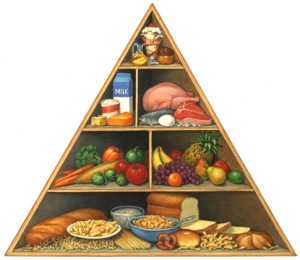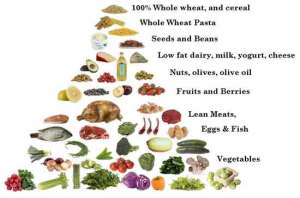Carbs Hate You, They Really Do!
Like most of western society you probably rely on a lot of carbohydrates to fuel your body and give you the energy you need to go to work, socialise, learn and (hopefully) exercise. All through our lives we are told that we need to get most of our energy from carbs in the form of breakfast cereal, sports drinks, pasta, bread and thousands of other types of carbohydrates. There is even a nice little pyramid which the government had drawn up to show us just how much we should rely on carbs – I can distinctly remember seeing one up on the home economics wall during classes and even doing an exam on it as well. Here is the little b&*$@&d for you to remember:
As you can see it says we should be eating loads of bread and pasta but surely if you think with a clear head this cannot make sense as everything in the “eat loads of” section is MANMADE! I’m actually a bit embarrassed to say I have just realised that, but I guess we’ve all been duped into not seeing it either. So what this means is that we should mainly rely on man made food that is not naturally produced and has only been introduced into our diet in the last few thousand years out of potentially millions?? Of course that is wrong it can’t make sense….but what I’m going to talk about now does (and if it doesn’t sorry about that)
WE AREN’T DESIGNED TO USE CARBOHYDRATES AS OUR MAIN ENERGY SOURCE!!
As a personal trainer it is my job to help my clients that I train around London to reach their goals, be they to lose weight or put it on, to get fitter or look fitter and to generally make them feel better than they currently do about themselves. I also train myself to feel good about myself as does anyone who partakes in exercise. It is whilst on this train of thought that I also have to look at what my clients are eating as at the end of the day even the most devoted Spartan will only clock up 5-10 hours of exercise a week compared to at least 14 hours plus of eating and drinking. The best part of this is that I can help you other guys that are not training with me to improve the way you approach diet as well as all you have to do is read 🙂
Lets get down to the basics. It is quite complex but I’m gonna write it as simple as I know how because if I can get you to understand this then already you are closer to the healthy body you want (I was gonna say deserve but it sounds way too American!).
When you eat food, your body digests the macronutrients: carbohydrates, proteins and fats. (Anything it can’t digest, like alcohol or fiber, either passes right on through or, if it makes it into the bloodstream, gets filtered by your liver, the poor organ has to deal with a lot from you city guys 🙂 ) We measure these macronutrients in grams and calories, but your body operates in terms of fuel. If you eat more fuel than your body needs, which by the looks of things most people do, the body is forced to store this excess. This ability to store excess fuel was an evolutionary necessity in a world that was in a state of constant “feast or famine” 50,000 years ago. This means that we are all fat storage specialists thanks to this built in safety device when there weren’t as many eat as much as you like buffets!
Keep in mind that every type of carbohydrate you eat is eventually converted into a simple form of sugar known as glucose, either directly in your gut or after a brief visit to your liver. The truth is, all the bread, pasta, cereal, potatoes, rice, fruit, dessert, sweets, and fizzy drink you eat and drink eventually wind up as glucose. While glucose is a fuel, it is actually pretty toxic in excess amounts unless it is being burned inside your cells, so the body has evolved a cool way of getting it out of the bloodstream quickly and storing it in those cells……yippeeeeee
It does this by having the liver and the muscles store some of the excess glucose as glycogen. That’s the muscle fuel that hard anaerobic (explosive) exercise requires. Specialised cells in your pancreas sense the increase of glucose in the bloodstream after a meal and secrete insulin, a hormone whose job it is to allow glucose (and fats and amino acids) to gain access to the interior of muscle and liver cells.
But here’s the catch: once those cells are full, as they are almost all the time with inactive people, the rest of the glucose is converted to fat. Saturated fat. Cue this geezer…..
Okay that was a bit hard going reading something so scientific but I just put it in as if you did read it and understand it then it will help you look at carbs differently as well as open your eyes to the fact that it isn’t high fat that is the problem but high carbs. Here is a link to an Economist article to further explain the evils of carbs
If you did skip large chunks because it bored/baffled you then at least you can read below as it is a direct guideline to starting to eat to get a better and healthier physique. I was halfway through writing it when I saw a better version written by Mark Sisson a real hero when it comes to good living:
300 or more grams/day – Danger Zone!
Easy to reach with the “normal” Western diet (cereals, pasta, rice, bread, waffles, pancakes, muffins, soft drinks, packaged snacks, sweets, desserts). High risk of excess fat storage, inflammation, increased disease markers including Metabolic Syndrome or diabetes. Sharp reduction of grains and other processed carbs is critical unless you are on the “chronic cardio” treadmill (which has its own major drawbacks).
150-300 grams/day – Steady, Insidious Weight Gain
Continued higher insulin-stimulating effect prevents efficient fat burning and contributes to widespread chronic disease conditions. This range – irresponsibly recommended by the USDA and other diet authorities – can lead to the statistical US average gain of 1.5 pounds of fat per year for forty years.
100-150 grams/day – Primal Blueprint Maintenance Range
This range based on body weight and activity level. When combined with Primal exercises, allows for genetically optimal fat burning and muscle development. Range derived from ancestors’ example of enjoying abundant vegetables and fruits and avoiding grains and sugars.
50-100 grams/day – Primal Sweet Spot for Effortless Weight Loss
Minimizes insulin production and ramps up fat metabolism. By meeting average daily protein requirements (.7 – 1 gram per pound of lean bodyweight formula), eating nutritious vegetables and fruits (easy to stay in 50-100 gram range, even with generous servings), and staying satisfied with delicious high fat foods (meat, fish, eggs, nuts, seeds), you can lose one to two pounds of body fat per week and then keep it off forever by eating in the maintenance range.
0-50 grams/day – Ketosis and Accelerated Fat Burning
Acceptable for a day or two of Intermittent Fasting towards aggressive weight loss efforts, provided adequate protein, fat and supplements are consumed otherwise. May be ideal for many diabetics. Not necessarily recommended as a long-term practice for otherwise healthy people due to resultant deprivation of high nutrient value vegetables and fruits.
The real food pyramid for optimal health:
I really hope you took this in as it will make you feel a whole lot better this I can guarantee you as will the people that have tried it before you.
Please comment and ask any more questions as information is the most powerful weapon against the belly belly 🙂








